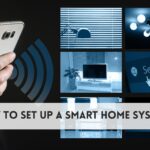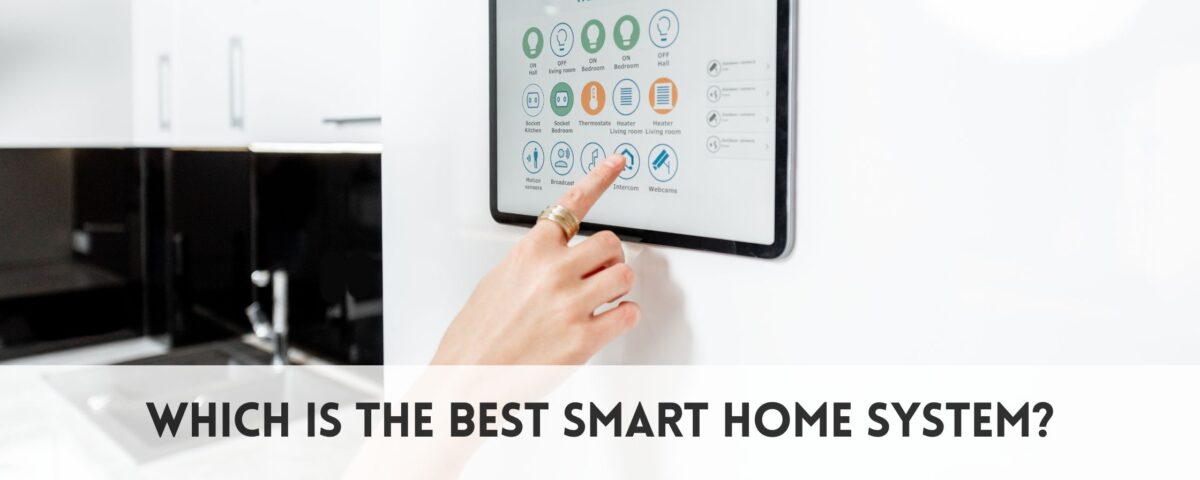
How to set up a smart home system?
May 14, 2025A smart home system consists of a network of connected devices that enable homeowners to automate, monitor, and control various aspects of their homes remotely. Common components include smart lighting, thermostats, security cameras, door locks, and voice assistants, all designed to work seamlessly together. So, Which is the best smart home system? These systems enhance daily convenience by allowing users to manage home functions through smartphones or voice commands, improving security by enabling real-time monitoring and alerts, and boosting energy efficiency with automated controls.
Advancements in technology have made smart home systems more accessible and easier to use than ever before. Modern setups often feature intuitive apps, straightforward installation processes, and compatibility with a wide range of devices and platforms. This evolution means that whether you’re upgrading an existing home or building a new one, integrating smart technology is simpler and more affordable. Understanding how these systems operate and their key benefits helps homeowners make informed decisions about adopting smart home solutions.
Which is the best smart home system?
Determining the best smart home system depends largely on your individual needs, the devices you already own or plan to buy, your security priorities, and your budget. The smart home market is dominated by several leading platforms, each with unique strengths designed to cater to different user preferences.
Amazon Alexa is known for its extensive device compatibility and wide range of affordable smart devices. It offers robust voice control capabilities and an expansive ecosystem, making it a popular choice for users looking for versatility and ease of use.
Google Nest stands out with its powerful AI integration and seamless Google Assistant support. It excels in providing smart displays and intelligent automation, especially for users already invested in the Google ecosystem.
Apple HomeKit offers top-tier privacy and security, with strict data encryption and seamless integration across Apple devices. It is ideal for users who prioritize privacy and use iPhones, iPads, or Macs.
Samsung SmartThings supports a broad variety of devices and protocols like Zigbee and Z-Wave, providing flexibility and powerful automation options. It appeals to users seeking a customizable smart home experience.
Hubitat Elevation emphasizes local control and privacy, minimizing reliance on cloud services. This system suits tech-savvy users focused on security and reliability.
Ultimately, the best smart home system balances compatibility, security, ease of use, and cost to fit your lifestyle.
Criteria for Choosing the Best Smart Home System
While deciding which is the best smart home system, consider the following criteria to ensure you select the perfect system for your home:
| Criteria | Importance |
| Device Compatibility | Supports a wide range of smart devices and brands |
| User Experience | Intuitive app interface and easy setup |
| Voice Assistant Support | Integration with Alexa, Google Assistant, Siri, etc. |
| Security & Privacy | Robust encryption and data protection |
| Automation Flexibility | Ability to create custom routines and smart scenes |
| Reliability | Stable connection and minimal downtime |
| Price | Affordability of hubs, devices, and any subscription fees |
- Device Compatibility is essential — the smart home system should support a wide range of devices, including lighting, security cameras, thermostats, and more. This ensures flexibility and future expansion.
- User Experience matters greatly; an intuitive, easy-to-navigate app simplifies setup and daily management, making the system accessible even to beginners.
- Voice Assistant Support is another important criterion. The system should integrate smoothly with popular assistants like Amazon Alexa, Google Assistant, or Apple Siri to enable convenient hands-free control.
- Security and Privacy are top priorities. Choose a system that offers strong encryption and data protection, as smart home devices handle sensitive personal information.
- Automation Flexibility allows you to customize routines and smart scenes tailored to your lifestyle, maximizing convenience and efficiency.
- Reliability refers to consistent performance with minimal downtime, ensuring your smart home functions smoothly at all times.
- Lastly, consider Price, including the cost of hubs, devices, and any subscription fees, to find a system that fits your budget without compromising quality.
Top Smart Home Systems Compared
| Smart Home System | Compatibility | Voice Assistant | Key Features | Price Range | Security Level |
| Amazon Alexa | Zigbee, Wi-Fi, wide device support | Alexa | Extensive device ecosystem, routines, skills | $50-$300+ | High (AES encryption) |
| Google Nest Hub | Wi-Fi, Thread, broad device support | Google Assistant | AI-powered controls, smart display | $80-$350+ | High (Google security) |
| Apple HomeKit | Apple devices only | Siri | Strong privacy, seamless iOS integration | $100-$400+ | Very High (end-to-end encryption) |
| Samsung SmartThings | Zigbee, Z-Wave, Wi-Fi | Alexa, Google Assistant | Versatile, supports many devices | $70-$300+ | Moderate |
| Hubitat Elevation | Zigbee, Z-Wave | None (3rd party apps) | Local control, privacy-focused | $100-$250 | Very High (local control) |
Features to Look for in the Best Smart Home System
This complete breakdown will help you identify the essential features that make a smart home system truly effective, reliable, and adaptable to your lifestyle.
Wide Device Compatibility
- Supports a broad range of smart devices from multiple manufacturers, including smart bulbs, locks, cameras, and thermostats.
- Enables integration with both popular and niche brands to avoid being locked into one ecosystem.
- Ensures future-proofing by supporting emerging standards like Zigbee, Z-Wave, and Thread for greater flexibility.
Voice Control Support
- Compatible with leading voice assistants such as Amazon Alexa, Google Assistant, and Apple Siri for hands-free control.
- Allows you to manage devices and trigger automation using simple voice commands from anywhere in your home.
- Supports multi-user voice recognition for personalized experiences and enhanced security.
Custom Automation
- Offers the ability to create complex routines based on time, location, or device status to suit your daily habits.
- Supports “if-this-then-that” (IFTTT) logic for advanced, personalized smart home interactions.
- Enables automation across multiple devices and platforms for a fully integrated smart environment.
Security and Privacy
- Utilizes strong encryption protocols to protect your data from unauthorized access.
- Provides options for local device control, minimizing reliance on cloud services to enhance privacy.
- Includes regular security updates and supports two-factor authentication for user accounts.
User-Friendly Interface
- Features an intuitive mobile app with a clean design, making setup and daily management straightforward.
- Offers clear notifications and easy access to device status and controls.
- Includes helpful customer support resources, such as tutorials and troubleshooting guides, for a smooth user experience.
Scalability
- Supports seamless addition of new devices without requiring complex reconfiguration or new hubs.
- Enables easy integration of emerging smart home technologies and upgrades over time.
- Ensures the system can grow with your needs, whether you’re adding security devices, entertainment systems, or energy management tools.
Pros and Cons of Popular Smart Home Systems
Choosing the best smart home system requires understanding the strengths and weaknesses of each platform. This section highlights the key advantages and potential drawbacks of the most popular smart home systems to help you make an informed decision.
| System | Pros | Cons |
| Amazon Alexa | Huge device ecosystem, affordable, voice control | Privacy concerns, cloud-dependent |
| Google Nest Hub | Strong AI features, excellent voice control | Best within Google ecosystem only |
| Apple HomeKit | Excellent privacy, seamless Apple integration | Limited to Apple ecosystem devices |
| Samsung SmartThings | Wide device support, versatile automation | Complex initial setup for beginners |
| Hubitat Elevation | Local control ensures privacy and speed | No native voice assistant, less user-friendly |
Evaluating these pros and cons will give you clearer insight into which system aligns best with your needs, preferences, and budget.
How to Decide Which is the Best Smart Home System for You?
These systems typically include smart lighting, thermostats, security cameras, door locks, and voice assistants, all working together to enhance convenience, security, and energy efficiency.
Existing Devices:
- Choose a system compatible with your current devices to avoid extra costs.
- Apple users may prefer HomeKit for seamless integration across iOS devices.
- Amazon and Google ecosystems offer broad device compatibility for mixed-brand setups.
Budget:
- Determine your spending limit for hubs and smart devices upfront.
- Consider total costs, including subscription fees for premium features.
- Affordable systems like Amazon Alexa offer entry-level options without sacrificing functionality.
Privacy Concerns:
- Decide if you prefer cloud-based systems with remote access or local control for enhanced security.
- Systems like Hubitat Elevation provide local processing, reducing data exposure risks.
- Evaluate encryption standards and data handling policies of each platform.
Voice Assistant Preference:
- Select a system that supports your preferred voice assistant—Alexa, Google Assistant, Siri, or none.
- Voice assistant integration impacts ease of use and smart home automation capabilities.
- Some systems offer multi-assistant compatibility for greater flexibility.
Desired Complexity:
- For simple tasks, choose systems with straightforward automation and user-friendly apps.
- Advanced users may benefit from platforms supporting custom routines and complex smart scenes.
- Ensure the system can scale with your smart home’s future expansion plans.
Final Words
So, Which is the best smart home system? In 2025, choosing the best smart home system is a highly personalized decision that depends on your unique needs and preferences. Amazon Alexa and Google Nest stand out for their wide device compatibility and powerful voice control features, making them ideal for users seeking convenience and flexibility. Apple HomeKit is the top choice for those prioritizing privacy and seamless integration within the Apple ecosystem.
Samsung SmartThings offers a versatile platform that supports numerous devices and advanced automation, suitable for users wanting a customizable smart home experience. For privacy-conscious users, Hubitat Elevation provides local control, minimizing reliance on cloud services and enhancing security. When selecting the best smart home system, carefully assess factors such as device compatibility, user-friendliness, security features, and overall cost. Making the right choice will help you create a smarter, safer, and more efficient living environment tailored to your lifestyle and technological preferences.

